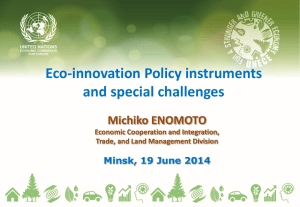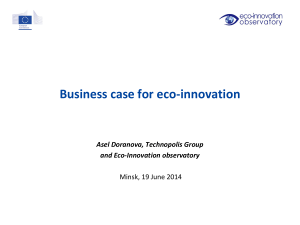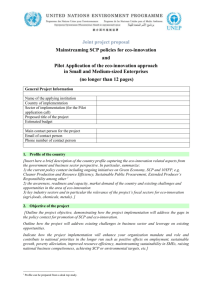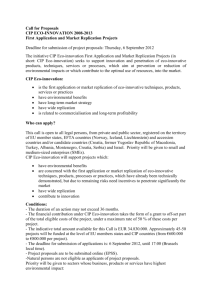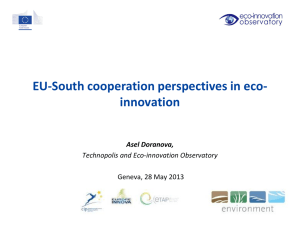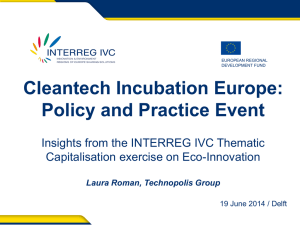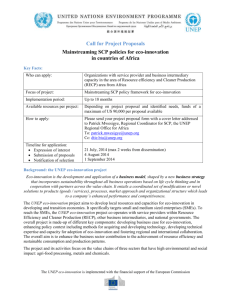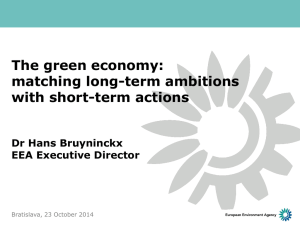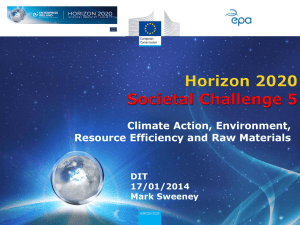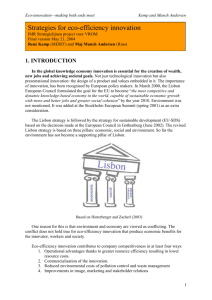Eco-innovation - INTERREG project recommend
advertisement
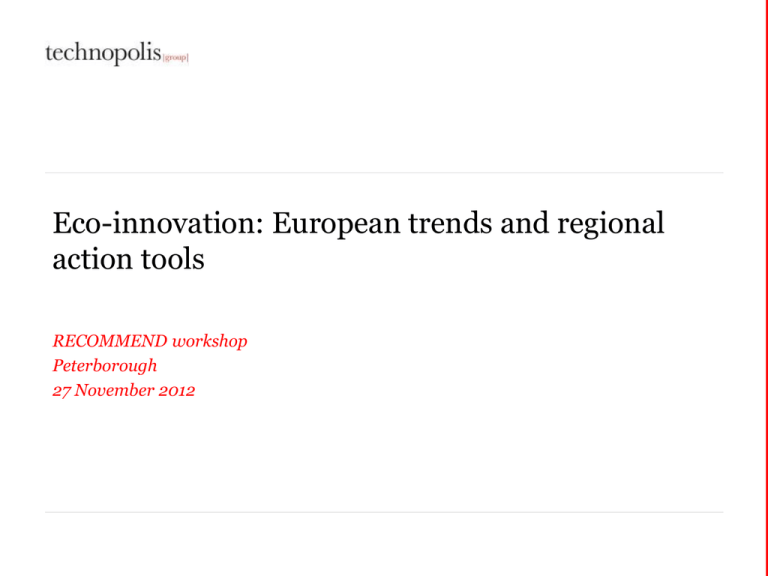
Eco-innovation: European trends and regional action tools RECOMMEND workshop Peterborough 27 November 2012 Eco-innovation trends in Europe 2 What is eco-innovation? 3 What is eco-innovation? Eco-innovation is any innovation that reduces the use of natural resources (including materials, energy, water, biomass and land) and decreases the release of harmful substances across its whole lifecycle. 4 What is eco-innovation? Eco-innovation is any innovation that reduces the use of natural resources and decreases the release of harmful substances across its whole life-cycle. impact on environment (resources and emissions) impact on economy (turnover, profit, sales, exports, jobs) impact on society (jobs, quality of life) 5 Why eco-innovation? 6 Why eco-innovation? The EU has achieved a relative de-coupling of GDP growth from material use. The absolute level of consumption has continued to grow in the same time. 7 Why eco-innovation? • Saving material and energy costs • New products and services: new markets • New business models • Sustainable management of resources • Tackling climate change • Improving biodiversity •Decrease the environmental footprint • Quality of life and green jobs • Resource justice economy environment social politics • Material security 8 EU Eco-innovation scoreboard 2012 EI Leaders Good EI achievers Average EI performers Countries catching up in EI 9 EU Eco-Innovation scoreboard breakdown 10 Eco-innovators in the EU (CIS 2008) Share of companies reporting reduced material use per unit of output as a result of innovation (red) and share of companies with any innovation activity (black) 11 Eco-innovators in the EU (Eurobarometer 2011) • • 45% of companies in Europe in manufacturing, construction, agriculture, water and food services have introduced at least one ecoinnovation in the past two years (Eurobarometer 2011) Result of innovation introduced in company in (the past 24 months) in terms of resource efficiency? 2% 2% 10% 10% 34% 42% More than 60% reduction of material use per unit output Between 40% to 60% reduction of material use per unit output Between 20% to 39% reduction of material use per unit output Between 5% to 19% reduction of material use per unit output Less then 5% reduction of material use per unit output DK/NA 12 Benefits from eco-innovation DEMEA • Material efficiency improvements in companies advised by DEMEA (German Material Efficiency Agency) could lead on average to € 200,000 savings per company. The savings could be achieved with an investment of under €10,000 in nearly half of the companies covered by the scheme (Demea 2010) 13 Eco-innovation trends • • • • • Eco-innovation activity is widespread among European companies Eco-innovation can lead to a substantial reduction of material cost of companies There is a high degree of diversity in EU in terms of eco-innovation performance Majority of EU companies report incremental eco-innovations Strong eco-innovation performance does not automatically lead to strong environmental performance in absolute terms 14 How can regions support the development of eco-innovation? 15 Approaches to regional eco-innovation support • Although competences and responsiblities vary significantly from one country to another, regions are legitimate stakeholders: • Regions can play a role as consumer (e.g. energy and implementation of energy saving activities, green public procurement); • Regions may be local producers and supplier of services & utilities (e.g. heating and energy solutions) • Regions may play a role as regulators, setting standards and local laws • Regions can play a role as as motivator and facilitator, inspiring and supporting the adoption of eco-innovative practices 16 Approaches to eco-innovation at the regional level Sectors Issues Ecoinnovation Targets Processes Techs Policies 17 Typology of eco-innovation policy support instruments Criteria Groups Funding mode Non financial Financial: guarantees, loans, fiscal incentives, grants/subsidies/vouchers, venture capital Position of support in innovation chain Supply side focus: Equity/business support, support for R&D: basic research, support for R&D: applied research, support for R&D: development & demonstration; education, training and mobility; networks and partnerships Demand side focus: Regulations and standards; Public procurement; Guarantees & other support for additional risks of early buyers; Export promotion activities; Support for private demand Specificity for eco-innovation Relevant for EI but EI not specifically focused Focused on eco-innovation (but applicable in other areas of innovation) Only possible in area of EI (e.g. regulation) Thematic focus Generic Focused one environmental issue: Resource efficiency, Energy efficiency Focused on environmental management processes: Eco-management, eco-design Other Measurement/ benchmark instrument, Eco-innovation strategies, Eco-innovative solutions (product, process, technology), eco-innovation assessment tools 18 Thank you Carlos Hinojosa Technopolis Group carlos.hinojosa@technopolis-group.com technopolis |group| has offices in Amsterdam, Ankara, Brighton, Brussels, Frankfurt/Main, Paris, Stockholm, Tallinn and Vienna 19
